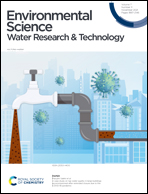A case study on tap water quality in large buildings recommissioned after extended closure due to the COVID-19 pandemic†
Abstract
Extensive building closures due to the unprecedented COVID-19 pandemic resulted in long-term water stagnation within the plumbing of large buildings. This study examined water chemical quality deterioration in ten large buildings after prolonged stagnation caused by the closure of a university campus in response to the COVID-19 pandemic. Volume-based and constant-duration flushing protocols were implemented to replace stagnant water with fresh drinking water. The effectiveness of the developed water flushing protocols was examined by monitoring the disinfectant residuals, heavy metal concentrations and temperature for water samples collected from the buildings' point of entry (POE) and select water fixtures. More than 14 m3 of water were flushed in all ten large buildings. The results demonstrated a significantly greater average total chlorine residual concentration in POE water samples collected after flushing (1.1 mg L−1) compared to the stagnant condition (0.6 mg L−1). For water samples collected from fixtures during the extended stagnation, chlorine was absent in 71% of samples from academic buildings and 69% of samples from athletic buildings. The effectiveness of flushing practices is underscored by increasing the median total chlorine concentration from <0.1 to 1.0 mg L−1 in academic buildings and from <0.1 to 0.75 mg L−1 in athletic buildings. Furthermore, the concentrations of Pb, Zn, and Cu had decreased following the water flushing, but the concentration of Fe had increased in some buildings. This study could be beneficial to prepare for prolonged water stagnation events including but not limited to pandemics.

- This article is part of the themed collections: SDG6: Clean water & sanitation, Environmental Science – coronavirus research and Best Papers 2021 - Environmental Science: Water Research & Technology


 Please wait while we load your content...
Please wait while we load your content...